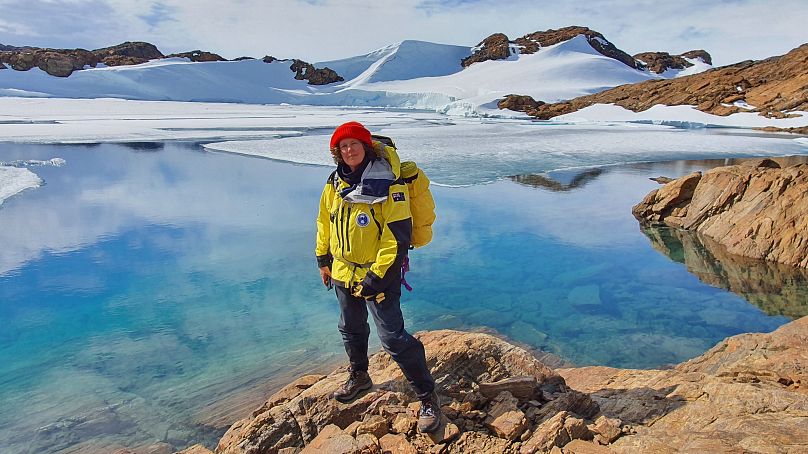Dana Bergstrom spent this summer - like many others - on the ice. She'd never seen it like this before.
One day in January, Dana Bergstrom woke up to rain drops on her window.
It would have been a relatively unremarkable occurrence at home in Hobart, Tasmania, but Bergstrom was at the Davis Research Station in the Vestfold Hills, Antarctica.
“You look up [and] think: That’s not right,” she told Euronews, “what’s happening here?”
With annual rainfall of just 6.5 inches, Antarctica is technically considered a desert, but the two days of drizzle Bergstrom - an ecologist with the Australian Antarctic Division - witnessed was just one of a number of remarkable weather phenomenon observed by scientists in 2020.
A heatwave began in late spring to the east of the Antarctic Peninsula and circumnavigated the continent. The Casey Research Station, south of Australia, saw three days of record-breaking temperatures, culminating in the all-time high of 9.2C on 24 January.
Antarctica’s heatwave made international headlines on 6 February when its highest ever temperature - 20.75C - was recorded on Seymour Island, just off the Antarctic Peninsula, the narrow arm that juts out into the Southern Ocean to within 1,000 kilometres of South America.
At Bergstrom’s station in the typically ice-free Vestfold Hills, the landscape was transformed. New rivers were formed in the ice, existing lakes flooded and new ones were formed. The ice runway where planes land from Australia was inaccessible for ten weeks.
“We had heat waves where we’ve never had heat waves before. We had heatwaves in the Windmill Islands, which is Casey Station, directly south of Perth. Where I was in the Vestfold Hills - which is below India - we had really really warm conditions,” she said.
Then there was the rain, which for two days soaked the scientists clothes. It even left the seals confused: “They looked a bit miserable in the rain,” she said. “They’re going: ‘What’s this stuff?”
The reason for rising temperatures in Antarctica are complex, ranging from the lateness of the Indian monsoon season, to warmer patches of water in the Pacific Ocean, to the position of the hole in the Ozone layer, to the strength of jet stream winds across the Southern Ocean.
“It is a story all the way around the continent, and it is a story that connects the atmosphere from the surface to the stratosphere and from the tropics to the poles. It shows how the weather systems are connected right across the world,” Bergstrom said.
“We’re seeing that when there is an extreme event in one place, there is also going to some form of extreme event elsewhere.”
While she and her colleagues were in Antarctica, her native Australia was a victim to extreme weather with catastrophic results. At the base, live news was streamed in order that the scientists could watch the latest updates of the worst bushfires in Australia’s history.
“We had colleagues who were wondering if their house was going to be there when they came home,” she said.
A few weeks later, the COVID-19 pandemic began, and worsened as Bergstrom boarded a ship for the two week journey from Antarctica to Tasmania, with no internet or phone reception. Arriving back home earlier this month, the coronavirus crisis was in full swing.
In the way that it has altered the way that billions of people live, the COVID-19 pandemic could be a taste of what is to come if the world fails to slow the pace of climate change, she says.
“The pandemic will get better. We will get a vaccine, herd immunity will develop, and we will start to rebuild [...], but with climate change at the moment [...] we’re not heading in the right direction: the costs will mount and mount and mount,” she said.
“Antarctica is the canary in the mine. If it is happening at the extreme edge of life, then you’re going to see it elsewhere. This happened after an extraordinary summer in Australia where the whole east coast literally went up in flames.”
Despite this, Bergstrom remains and optimist, and is buoyed by how communities have rallied to help and protect each other from COVID-19 in recent weeks
“Looking at what we’re seeing now: Communities are pulling together. People are becoming heroes and leaders in their communities. Again, from COVID-19, we can see optimism,” she said.
“So what we need is for people to realise that climate change is a big message as well so that communities and government can respond. So that everyone can do their part.”












